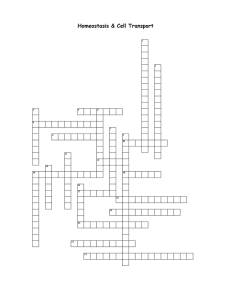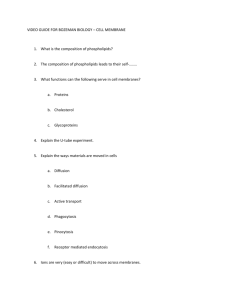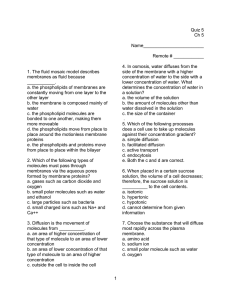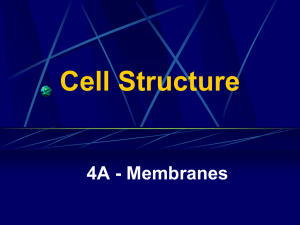WHAT TO KNOW ABOUT HOMEOSTASIS & TRANSPORT
advertisement
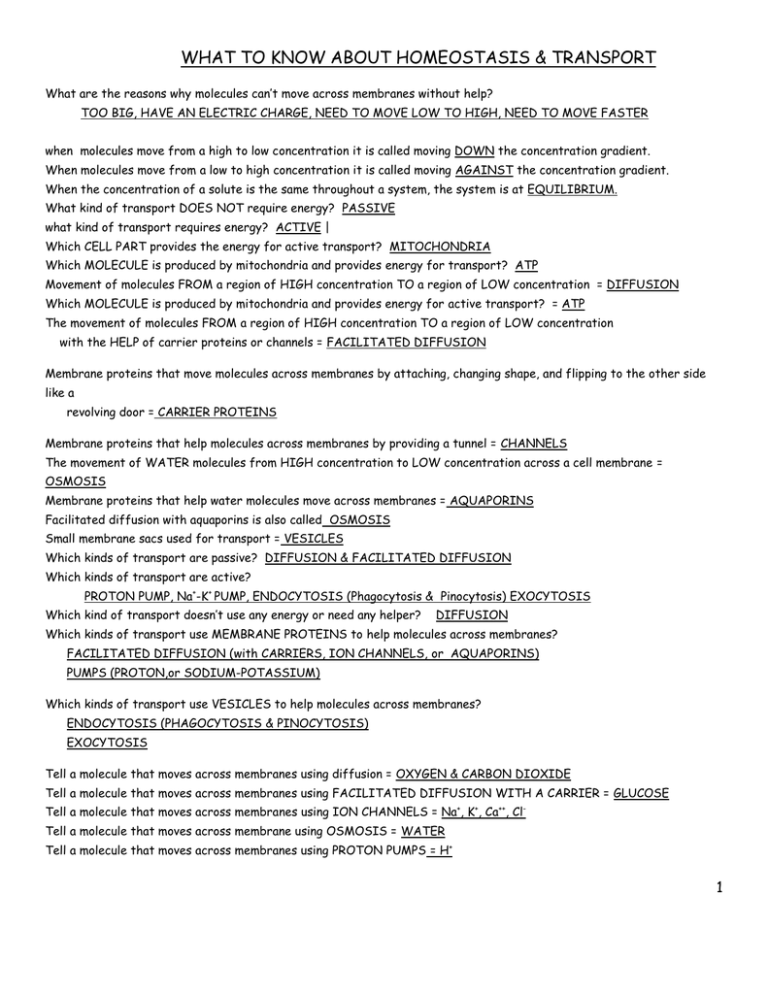
WHAT TO KNOW ABOUT HOMEOSTASIS & TRANSPORT What are the reasons why molecules can’t move across membranes without help? TOO BIG, HAVE AN ELECTRIC CHARGE, NEED TO MOVE LOW TO HIGH, NEED TO MOVE FASTER when molecules move from a high to low concentration it is called moving DOWN the concentration gradient. When molecules move from a low to high concentration it is called moving AGAINST the concentration gradient. When the concentration of a solute is the same throughout a system, the system is at EQUILIBRIUM. What kind of transport DOES NOT require energy? PASSIVE what kind of transport requires energy? ACTIVE | Which CELL PART provides the energy for active transport? MITOCHONDRIA Which MOLECULE is produced by mitochondria and provides energy for transport? ATP Movement of molecules FROM a region of HIGH concentration TO a region of LOW concentration = DIFFUSION Which MOLECULE is produced by mitochondria and provides energy for active transport? = ATP The movement of molecules FROM a region of HIGH concentration TO a region of LOW concentration with the HELP of carrier proteins or channels = FACILITATED DIFFUSION Membrane proteins that move molecules across membranes by attaching, changing shape, and flipping to the other side like a revolving door = CARRIER PROTEINS Membrane proteins that help molecules across membranes by providing a tunnel = CHANNELS The movement of WATER molecules from HIGH concentration to LOW concentration across a cell membrane = OSMOSIS Membrane proteins that help water molecules move across membranes = AQUAPORINS Facilitated diffusion with aquaporins is also called OSMOSIS Small membrane sacs used for transport = VESICLES Which kinds of transport are passive? DIFFUSION & FACILITATED DIFFUSION Which kinds of transport are active? PROTON PUMP, Na+-K+ PUMP, ENDOCYTOSIS (Phagocytosis & Pinocytosis) EXOCYTOSIS Which kind of transport doesn’t use any energy or need any helper? DIFFUSION Which kinds of transport use MEMBRANE PROTEINS to help molecules across membranes? FACILITATED DIFFUSION (with CARRIERS, ION CHANNELS, or AQUAPORINS) PUMPS (PROTON,or SODIUM-POTASSIUM) Which kinds of transport use VESICLES to help molecules across membranes? ENDOCYTOSIS (PHAGOCYTOSIS & PINOCYTOSIS) EXOCYTOSIS Tell a molecule that moves across membranes using diffusion = OXYGEN & CARBON DIOXIDE Tell a molecule that moves across membranes using FACILITATED DIFFUSION WITH A CARRIER = GLUCOSE Tell a molecule that moves across membranes using ION CHANNELS = Na+, K+, Ca++, ClTell a molecule that moves across membrane using OSMOSIS = WATER Tell a molecule that moves across membranes using PROTON PUMPS = H+ 1 Tell a molecule that moves Na+ out of cells and K+ into cells = Na+-K+ PUMP Tell a molecule that moves across membranes using PHAGOCYTOSIS = LARGE MOLECULES & WHOLE CELLS Tell a molecule that moves across membranes using PINOCYTOSIS = SMALL MOLECULES & FLUIDS Tell the kind of transport used by Golgi bodies for export = EXOCYTOSIS Tell the kind of transport used by white blood cells to digest bacteria = ENDOCYTOSIS (PHAGOCYTOSIS) Pressure caused by water moving across cell membranes = OSMOTIC PRESSURE The substance that is dissolved in liquid to make a solution = SOLUTE The liquid a substance is dissolved in to make a solution = SOLVENT EX: When making Kool-Aid, water is the solvent and the Kool-Aid and sugar are the solutes HYPOTONIC ISOTONIC HYPERTONIC Solute concentration OUTSIDE is Solute concentration OUTSIDE is Solute concentration OUTSIDE is LOWER THAN inside EQUAL to inside GREATER THAN inside Water will ENTER cell Water in = water out Water will LEAVE cell ANIMAL CELLS- ANIMAL and PLANT cells ANIMAL CELLS- will swell and burst will STAY THE SAME SIZE will shrink smaller PLANT CELLS- osmotic pressure will PLANT CELLS- osmotic INCREASE pressure will DECREASE CELL WALL keeps it from bursting Cell membrane pulls away from cell wall 2
